|  It's
wild and windy on the ridge at Shelley where I sketch
the drystone-walled hillside pastures across the valley around Upper Denby
from the window of the conservatory café at Armitage's Garden Centre.
It's so cold that even the polar bears are going into hibernation: we
see the guardians of Santa's Grotto being trundled off on the back of
trailer into storage until next year. It's
wild and windy on the ridge at Shelley where I sketch
the drystone-walled hillside pastures across the valley around Upper Denby
from the window of the conservatory café at Armitage's Garden Centre.
It's so cold that even the polar bears are going into hibernation: we
see the guardians of Santa's Grotto being trundled off on the back of
trailer into storage until next year.
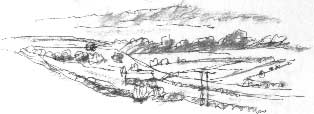 On
the way back I get a few minutes to sketch a similar view near Emley.
These exposed uplands have a wonderful wild, wide open look to it today;
exhilarating rather that crushingly bleak. On
the way back I get a few minutes to sketch a similar view near Emley.
These exposed uplands have a wonderful wild, wide open look to it today;
exhilarating rather that crushingly bleak.
I feel that this is a true Pennine landscape; that we're on, or almost
on, the millstone grit and that the open moors aren't far away. A few
miles away, around home, the softer landscape of the coal measures have
a more mundane, everyday quality.
 Chinatown in the Snow
Chinatown in the Snow
Thanks to getting a good session in on Monday, I'm now over half way
through Betty Edwards' Drawing with the Right Side
of the Brain. Before starting the exercises in drawing in perspective
from real life, Edwards suggests that her students should copy a street
scene or interior from a photograph.
There happens to be an August 1998 National Geographic on the
desk and this photograph of New York's Chinatown in the snow is the first
example I come across. I draw the right side (well, that's appropriate)
of a double page spread of an atmospheric photograph by Chien-Chi
Chang.
Imagine how difficult it would be to set up the vanishing points for
this scene: the buildings, as they curve into the distance, have at least
three separate vanishing points. The way to draw this is just the same
as the kitchen gadgets, the hand and the paper bag that I drew on Monday:
carefully observe and draw the individual shapes, one by one, as if you
were constructing a jigsaw made of unnamed, abstract pieces.
Edward's includes a quote from Nathan Goldstein's The
Art of Responsive Drawing:
To paraphrase Eugène Delacroix's observation on the study of
anatomy, perspective should be learned - and then forgotten. The residue
- a sensitivity to perspective - helps perception, varying with each
individual and determined by his responsive needs.
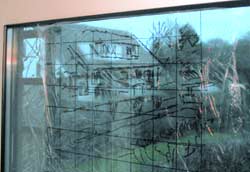 |
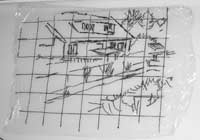
The view on cling-film
|
Grid
My next exercise seems a fiddly one but it's one worth trying.
Edward's gives instructions for putting a piece of cling-film on
a window, drawing a grid on it in marker pen then, being careful
to stand steadily in one position, to draw the perspective view
of the house or street you see beyond.
So as not to attract the astonished attention of passing neighbours
on the street, I draw from the patio doors at the back
of our house.
I'm surprised how much my head wobbles about as I'm drawing but
at least I get the basics of the scene. I carefully peel off the
film and carry it on my outstretched fingers up to the studio where
I spread it out on my perspex drawing board.
The final stage is to draw a grid, same size, on paper and copy
the drawing.
|
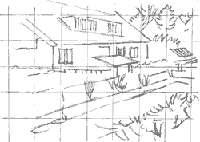
The grid copied onto paper.
|
 |
Corner
There are some lovely student drawings of corners of kitchens in
Right Side of the Brain so I've been looking forward to
this exercise. As my studio has a sloping roof I can't start with
the ceiling corner, as Betty Edwards suggests.
There are so many books that you can hardly see the corner itself
but that's fine for the point of the exercise, which is to build
up the perspective by observing adjacent shapes.
|
Foreshortened Finger
Perspective isn't just about drawing buildings: you need to be
aware of its effects when drawing figures (even if, for expressive
reasons, you then choose to ignore' true' perspective). This hand
- I didn't realise how similar the pose is to the one I drew on
Monday - was drawn starting at the fingernail of the index finger
which is pointing towards me and so foreshortened. 
|

Three satsumas: an exercise in perceiving relative sizes of
objects when seen in perspective.
|
|
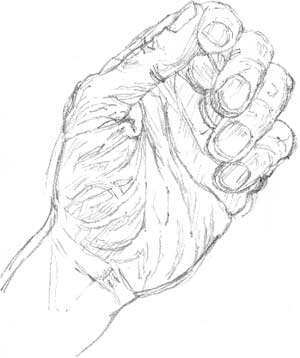 |
Richard Bell, richard@willowisland.co.uk |
![]()

